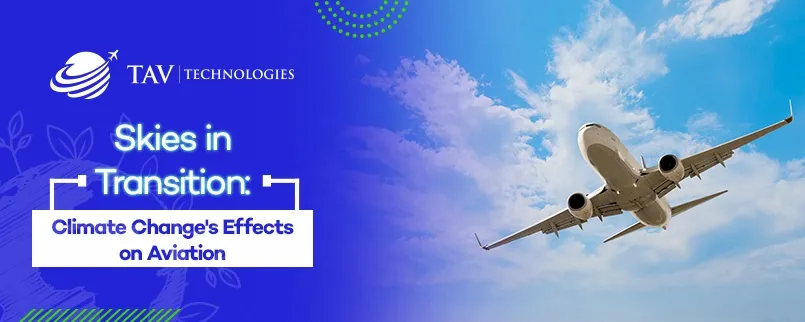
Dec 2023
The profound shifts induced by climate change significantly affect the aviation sector. As we look at how the weather affects air travel, it's clear that it has a wide range of effects, impacting things like how long flights take and overall safety.
How Climate Change Affects Air Travel
In recent years, the frequency of extreme weather events, including storms, hurricanes, and heatwaves, have increased due to climate change. These events pose a significant threat to the reliability and safety of air travel. Recognizing this, aviation stakeholders are investing in cutting-edge meteorological and climate monitoring technologies. These systems use real-time data from satellites, weather stations, and atmospheric sensors to provide accurate and up-to-date information on changing weather conditions.
The changing climate directly influences flight times. The unpredictability of weather patterns can lead to longer flight durations, fuel inefficiencies, and increased operational costs. In response, the aviation industry is leveraging advanced air traffic management systems incorporating artificial intelligence and machine learning algorithms. These systems analyze current weather conditions and historical flight patterns to optimize flight routes in real time. By dynamically adjusting routes based on the latest information, airlines can enhance fuel efficiency, reduce emissions, and minimize delays.
What Is the Relationship Between Climate Change and Flight Safety?
The shifting climate can result in changes to traditional flight routes, airport operations, and even the design and performance of aircraft. To address these evolving risks, the aviation industry is actively engaged in the development and implementation of advanced communication systems.
Enhanced communication systems play a crucial role in ensuring that pilots, air traffic controllers, and other stakeholders have access to timely information. This includes real-time weather updates, alerts about potential climate-related hazards, and changes in air traffic management directives. Modern communication technologies, such as satellite-based communication and data-link systems, facilitate seamless information exchange between aircraft and ground control.
Real-time monitoring is another key aspect of ongoing safety efforts in the aviation sector. Advanced monitoring systems leverage a network of sensors and data analytics to continuously assess various parameters, including weather conditions, atmospheric pressure, and turbulence levels.
Furthermore, the aviation industry is investing in the development of predictive modeling tools that use historical climate data and advanced algorithms to anticipate potential safety risks. These tools enable airlines and regulatory authorities to assess the potential impact of climate change on specific flight routes, airports, and aircraft types.
Climate Change’s Impact on Passengers
As climate change awareness grows, passengers are increasingly conscious of the environmental impact of air travel. Airlines are implementing eco-friendly initiatives to meet the expectations of environmentally conscious passengers, including sustainable airport designs and energy-efficient systems to create a greener flying experience.
We need standardized information about airline emissions if we want passengers to choose low-emission flights. Achieving this requires teamwork among regulators, airlines, travel search engines, and environmental groups. Once this system is established, it could motivate more all stakeholders to provide more low-emission options, speeding up the overall move toward greener air travel.
Effective climate action necessitates a crucial role from policymakers. A compelling illustration of this influence is evident in France's decisive prohibition of domestic short-haul flights where viable train alternatives exist, aimed at curbing carbon emissions.
What is Net Zero Carbon Emission Target in Aviation?
The United Nations Net Zero Carbon target drives industries, including aviation, to cut emissions and embrace sustainability. This shift requires airports, crucial components of aviation, to lead in achieving Net Zero. Green airports are pioneering renewable energy use, like solar and wind power, reducing reliance on fossil fuels.
Sustainable designs prioritize energy-efficient buildings, from terminals to maintenance areas, using eco-friendly materials and technologies. Waste reduction is also key at green airports, with recycling programs and eco-friendly disposal methods. Sustainable transport solutions, like electric shuttles and charging stations, further cut carbon emissions within airport premises. This collective effort aligns with UN carbon neutrality goals.
How Will Climate Change and the Future of Air Travel Be Shaped?
The future of air travel is tied to the challenges posed by climate change. Ongoing research and development focus on sustainable airport technologies, encompassing everything from renewable energy sources to smart infrastructure. The goal is to create a resilient and environmentally responsible future for air travel.
One significant area of focus is the development of green airports. These airports aim to reduce their carbon footprint by incorporating renewable energy sources, such as solar and wind power, into their operations. Moreover, sustainable airport designs prioritize energy-efficient buildings, waste reduction, and eco-friendly transportation solutions within the airport premises.
The aviation sector is aware of the increasing intensity of extreme weather events and actively investing in modern technologies to ensure the safety of flights. As passengers become more environmentally conscious, airlines are implementing eco-friendly initiatives, shaping a greener flying experience. The future of air travel lies in sustainable practices, resilient airport technologies, and a collective commitment to environmental responsibility, as the industry charts a course towards a more sustainable and adaptable future.
